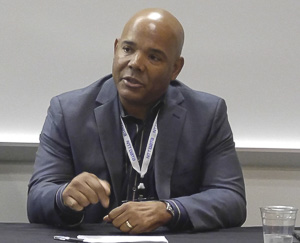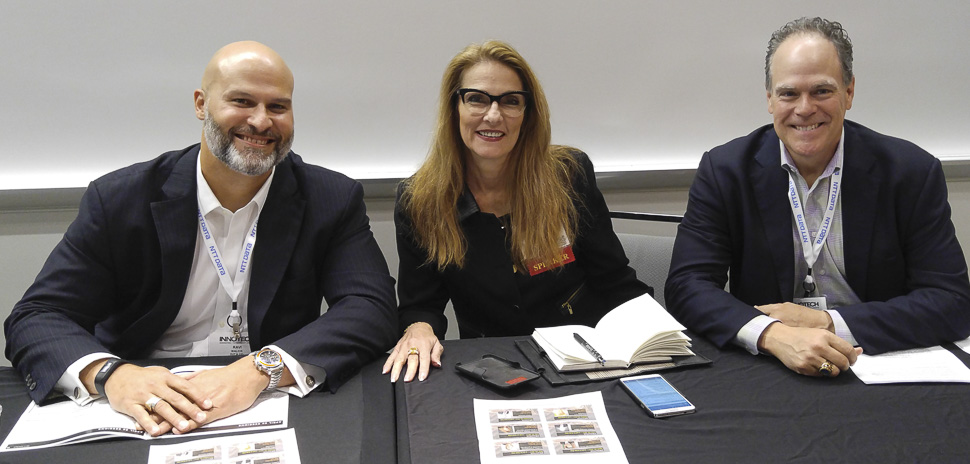![]() If you missed this year’s InnoTech Conference and Exhibition, you missed an exceptional opportunity to glean valuable and applicable IT insights from Dallas-Fort Worth tech leaders through the inaugural Technology Ball IT Leadership Track.
If you missed this year’s InnoTech Conference and Exhibition, you missed an exceptional opportunity to glean valuable and applicable IT insights from Dallas-Fort Worth tech leaders through the inaugural Technology Ball IT Leadership Track.
More than a dozen Technology Ball panelists offered blue-chip information, specialized insight on current trends, and their best predictions on the future of IT. Here we present the most important takeaways from the conference.
PREPARE AND POSITION YOURSELF NOW TO BE AN ASSET FOR IT INNOVATIONS IN THE FUTURE
PANEL
Gerry Mecca
Vice President IT, Packaged Beverages and Client Services, Dr Pepper Snapple
Gertrude Van Horn
CIO of NCH Corporation
Ravi Malick
SVP and CIO, Vistra Energy
Moderator: Mike Rochelle
Director, Global IT Strategy, Jacobs
The panel offered their expertise in how to perform well now while exploring the constantly changing IT landscape in a session entitled, CIO 2020: Positioning Yourself for the Next Shift.
To avoid being perceived as the “business prevention group.” it’s essential for tech leaders to respond internally to ill-suited proposals by presenting a better idea … the value of “x” vs “y”— rather than simply saying “NO” to “y.”
Mecca advised the importance of setting regularly-scheduled sessions for individual and team building throughout the year to allow each member to contribute ideas for development and innovation.
Malick continued the conversation by emphasizing the importance of leaders at all levels of IT group learning to communicate effectively with C-level executives. IT people tend to have their own language with which they communicate with one another.
Malick suggested that by dropping the so-called “geek-speak” and learning to view IT through the larger lens of the business as a whole, IT will have more influence going forward.

Gerry Mecca, VP IT, Packaged Beverages & Client Services at Dr Pepper Snapple.
Van Horn echoed the theme of investing in people as your greatest asset. She urged leaders to give team members the opportunity to try their ideas and allow them the freedom to fail without humiliation. Offering support and guidance will help them grow and enhance the likelihood of positive contribution and achievement in the future.
There was a consensus across the group that the IT department must be more careful than other departments in the organization when saying “no” to projects.
To avoid being perceived as the “business prevention group,” it’s essential for tech leaders to respond internally to ill-suited proposals by presenting a better idea, highlighting the value opportunity and best strategic direction for the overall business — the value of “x” vs “y” — rather than simply saying “NO” to “y.”
M&A TRANSACTIONS — WHY IT’S PARAMOUNT TO GET THE TECHNOLOGY FACTOR RIGHT!
PANEL
J. Mark Urbis
Former SVP & CIO, Animal Supply Company
Scott Sosnowski
President, NTT DATA
Paul S. Grant
SVP, Stakeholder Engagement Management Information Process Organization Function, Schneider Electric
Moderator: Andrew Jackson
President & Co-Founder, BravoTECH

Paul S. Grant, SVP, Stakeholder Engagement Management Information Process Organization Function at Schneider Electric: “Whether there is a high or low integration risk, and the cost for IT integration is not usually a deal breaker, but it helps if the IT group is in order”
The panel emphasized that when anticipating a merger or acquisition, adequate planning regarding IT expenditures is crucial. Ensuring the right systems are in place as the transition occurs can lower the risk of the venture.
Grant shared that risk management is a critical factor in M&A. Leaders must be informed about every aspect of the new company, so they can address concerns and potential problems in negotiation conversations.
Urbis suggested embracing a positive attitude toward the situation and the people. He believes it’s possible to be positive without sacrificing honesty and integrity, and that positivity is infectious and will encourage others to adopt a similar approach.
Sosnowski acknowledged the importance of recognizing the value in the people already in position at the company being acquired. He believes leaders must develop a strategy to retain valuable and knowledgeable people as the new entity is being built. If you can accomplish that, the transition will be less painful for everyone, including the all-important customer.
All panelists stressed the importance of open, honest communication from the IT Department during merger discussions to help a deal move forward.

Panel members from left to right: Moderator, Andrew Jackson; Scott Sosnowski; J. Mark Urbis; and Paul S. Grant [PHOTO: Courtesy of Technology Ball]
CAPITALIZING ON WORKFORCE TRENDS AND EMERGING TALENT
PANEL
Michael Bathon
SVP, IT, Goodman Networks
Mark BeMent
CIO, Jackson Walker, LLP
Moderator: Val King
Director of IT, Studio Movie Grill
BeMent emphasized that when assembling a team, diversity is crucial. He makes a practice of meeting every person to determine whether the job is a good fit for both the individual and the company. Success is dependent upon everyone being satisfied with the situation.
BeMent suggested it’s best to recruit from within when possible because current employees already understand and fit into the corporate culture.
He also suggested it’s best to recruit from within when possible because current employees already understand and fit into the corporate culture.
Bathon addressed the issue of hiring millennials, who may have little or no experience but high expectations. He said companies must become more agile to allow changes in the workplace, such as working remotely, offering rewards, and allowing flexible schedules to attract millennials.
KEY COMPONENTS IN GETTING PROJECTS APPROVED
PANEL
J.D. Stotts
CISO, VP Information Security, ACE Cash Express
Jeff Dinard
CIO, On the Border
Robby McDonald
Former CIO and CMO, SRS Distribution Inc.
Moderator: Kathy Mast
President & CEO, NEUVONOW
Dinard said that when presenting an idea to management, he offers three scenarios: “I have a Cadillac, a Chevy, and a bicycle approach. The Cadillac is the top-of-the-line, ideal scenario with everything a techie could want. The Chevy approach is the most cost-effective, and the bicycle option is just remaining steady with little expense.” This allows management to choose from three workable options to determine which will best serve the company.
When presenting an idea to management, Dinard offers three scenarios: “I have a Cadillac, a Chevy, and a bicycle approach.
Stotts emphasized the importance of understanding the goals of the executive team to present the project in the terms of business that most concern company leaders. He said the key is to remove all surprises from the equation when meeting with financial and other managers.
McDonald agreed that IT leaders must put their vision into an actionable approach that ties directly into management’s objectives for the company.
CLOUD ADOPTION—PAST, PRESENT, AND FUTURE—A 360-DEGREE VIEW
PANEL
Earl Barnes
Head of Global Infrastructure and Corporate Development, Flowserve
John Ragsdale
CIO, Senior Care Centers
Moderator: Elliott Franklin
VP of Infrastructure and Security, Omni Hotels
All panelists shared that their operations have already moved to the cloud or are in the process of doing so, citing Office 365, patient records, and Salesforce data integration.
Upon polling the audience, it was revealed that the majority of attendees cited security risk and privacy concerns as their primary obstacle in moving to the Cloud. Other, less significant factors included an inability to integrate existing internal systems and an inability to justify the ROI. Franklin also said that a common obstacle may be unknowns with transitioning the data.
Ragsdale pointed out concerns with what he calls “Shadow IT”, the practice of business units outside of IT executing their own IT solutions.
Barnes urged IT leaders to evaluate the value of private security versus the public cloud. He suggested that other questions must be posed as well: “who owns and manages the cloud?”. Leaders must have the assurance that they have control over the security of the data, as well as extracting it when needed.
Ragsdale pointed out concerns with what he calls “Shadow IT”, the practice of business units outside of IT executing their own IT solutions, circumventing the IT implementation processes — one that is often seen as cumbersome and slow moving. Because other departments do not possess the overarching view of the IT department, this approach presents threats to the company security, efficiency, systems compatibility, etc. and illustrates the need for integral and thoughtful IT involvement in technology decisions and implementation.
So what’s the ultimate takeaway?
If you missed this year’s Technology Ball IT Leadership Track at InnoTech, mark your calendar for April 2018, and plan to be on site for valuable IT mindshare and access to some of DFW’s most influential IT leaders. Visit http://www.innotechconferences.com/ for more information.

































